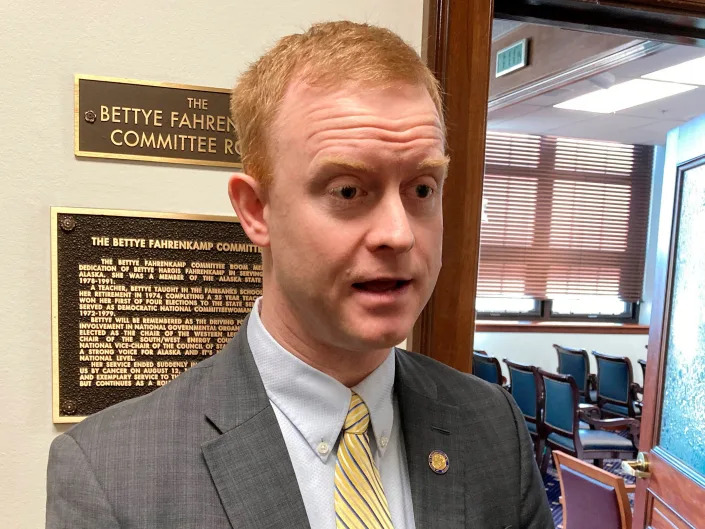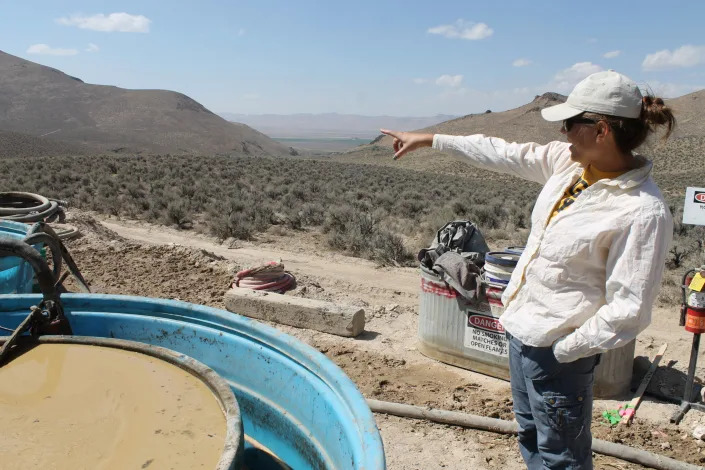5 unanswered questions on East Palestine derailment after preliminary NTSB report

Zack Budryk
Thu, February 23, 2023
The National Transportation Security Board (NTSB) issued its first preliminary report Thursday on the Feb. 3 derailment of a train carrying hazardous chemicals in East Palestine, Ohio.
While the report seemingly faults an overheated bearing for the derailment, the NTSB investigation is ongoing, and a number of questions remain.
Here are five remaining questions about the train derailment:
1. Did the tank car design contribute?
In the preliminary report, the NTSB said it has decontaminated the train cars that contained hazardous material, which included vinyl chloride. Exposure to the substance, which is used for production of plastics, has been linked to higher rates of liver and lung cancer.
NTSB officials said they have removed and examined the top fittings from the cars that contained the substance, and those fittings will be sent to Texas for further testing.
2. What was the role of rail regulations or lack thereof?
Public safety advocates have frequently pointed to the Trump administration’s delay of a 2015 rule, vocally opposed by railroad companies, that would require the use of more modern electronically-controlled pneumatic brakes.
Although the Transportation Department has said the rule would not have prevented the East Palestine disaster, both Transportation Secretary Pete Buttigieg and President Biden have pointed the finger at the railroad lobby for deregulation and its potential role in the accident.
3. Are there still environmental hazards?
The NTSB noted in its report that it is not involved in “air monitoring, testing of water quality, environmental remediation, or evacuation orders” relating to the disaster. Much of this falls under the purview of the Environmental Protection Agency (EPA), which has taken over the response. EPA Administrator Michael Regan said last week that the agency will require Norfolk Southern, which operates the railroad, to assume financial responsibility for all cleanup efforts.
While the EPA and Ohio Gov. Mike DeWine (R) have said water in the area tested as safe to drink, they recommended drinking bottled water, and state officials have reported at least 3,500 fish have died in surrounding waterways.
4. Was the controlled burn the right move?
DeWine ordered an evacuation of the area days after the derailment. Shortly after, concerned about a potential explosion due to the presence of flammable compounds, first responders conducted a controlled burn. In its preliminary report, the NTSB listed “venting and burning of the vinyl chloride” as an ongoing subject of investigation. A number of lawsuits have been filed in the meantime alleging the controlled burn exacerbated hazards, including a complaint by local injury firm Morgan & Morgan claiming it has contributed to locals’ health problems.
5. How long will it take to determine the exact danger?
Many of the potential risks associated with environmental disasters — from cancer to developmental issues — can take months or years to become apparent and will require ongoing investigations by both the NTSB and the EPA.
Regan and Ohio Sen. Sherrod Brown (D) have urged residents to continue testing their homes’ air quality, and Brown has also said he is working to ensure Norfolk Southern does not manipulate residents into waiving their right to sue.
Another unknown is any possible risk to the surrounding areas, not just other parts of Ohio but the other side of the state line as well. Pennsylvania Gov. Josh Shapiro (D) told NPR this week that Norfolk Southern’s response has “given the middle finger to the good people of Pennsylvania and Ohio” and that testing of western Pennsylvania water is ongoing as well. “We’ve seen no concerning readings yet, but we’re going to continue to test for months and months and months, if not years,” he said.
Four systemic safety issues the East Palestine crash report may point to Saul ElbeinFri, February 24, 2023 A new report on the catastrophic train derailment in East Palestine, Ohio, points to several possible systemic safety issues that advocates and safety experts say go well beyond this specific crash.The preliminary report released on Thursday by the National Transportation Safety Board (NTSB) found that the runaway overheating of a ball bearing in one of the train’s wheels caused it to careen off the tracks.Rail bearings are small in comparison to the size of a freight train, weighing about 80 pounds.But when they overheat, they can cause a great deal of damage. Historically, bearing failures have been a leading cause of train crashes, according to research from the University of Illinois, though last year they caused just 1 percent of derailments.Federal regulators, advocates and safety experts suggest the crashes could point to broad issues with federal regulations and the methods America’s freight railways use to detect and respond to overheating car wheels. Here are four possible problems they’ve raised.
Saul ElbeinFri, February 24, 2023 A new report on the catastrophic train derailment in East Palestine, Ohio, points to several possible systemic safety issues that advocates and safety experts say go well beyond this specific crash.The preliminary report released on Thursday by the National Transportation Safety Board (NTSB) found that the runaway overheating of a ball bearing in one of the train’s wheels caused it to careen off the tracks.Rail bearings are small in comparison to the size of a freight train, weighing about 80 pounds.But when they overheat, they can cause a great deal of damage. Historically, bearing failures have been a leading cause of train crashes, according to research from the University of Illinois, though last year they caused just 1 percent of derailments.Federal regulators, advocates and safety experts suggest the crashes could point to broad issues with federal regulations and the methods America’s freight railways use to detect and respond to overheating car wheels. Here are four possible problems they’ve raised.
The speed of the detection system
“Roller bearings fail. But it’s absolutely critical for problems to be identified and addressed early so these aren’t run until failure,” NTSB Chairwoman Jennifer Homendy said at a Thursday press conference.
Railroads like Norfolk Southern, the company that operated the train that derailed in East Palestine, rely on a network of temperature sensors every 10 to 40 miles. These are placed along rail lines to catch rising wheel temperatures before they reach the critical point at which breakdown is imminent.
Homendy pointed to one potential weakness in that network: the distance between its sensors. “Had there been a detector earlier, that derailment may not have occurred. But that’s something we have to look at,” she said.
Transporation Secretary Pete Buttigieg echoed these concerns in comments from East Palestine when he singled out the detectors as “something that needs to be looked at to try to prevent things like this from happening again.”
In the case of train 32M, which ultimately derailed in East Palestine, the NTSB report found that the train passed through two of these wayside hot-bearing detectors.
Those registered the train’s wheel temperature as hotter than average — but still below the “warm bearing” threshold that would have triggered an automatic inspection, let alone an emergency stop.
By the third detector, it was too late. Railside sensors noted that one of the wheels had soared to 253 degrees Fahrenheit above average and transmitted an alarm over the engine’s radio warning the crew to stop at once. At that point, the crew began emergency braking.
Emergency braking is far more aggressive than a train’s usual controlled stop — so violent that the force of the sudden braking can be enough to derail a train all by itself. By the time the train stopped, 38 cars had derailed — 11 of which carried hazardous materials.
Federal regulations — or the lack thereofThe report comes out amid charged and often conspiratorial speculation about the role the nation’s rail safety policies played in the crash.“We’ve been saying the same thing about a degrading safety culture for the past five years,” AFL-CIO transportation department head Greg Regan told The Hill.Regan and his colleagues pointed to federal data showing that the rate of incidents per train mile has doubled at Norfolk Southern since 2013 — and the rate of total accidents and accidents per mile also sharply increased.Rail critics have specifically highlighted what they say is a lack of adequate braking regulations in the wake of the East Palestine derailment. Rail industry lobbying weakened an Obama-era push to require new-model electro-pneumatic brakes — which cause railcar wheels to stop all at once, rather than in a slow backward cascade from the engines — to a simple mandate restricted to oil trains and other high-hazard flammable trains, as The Lever reported.Under the definitions adopted at the time, train 32M would not have needed to use the advanced brakes — even had the Trump administration not withdrawn that requirement in 2018.In proposed rail safety reforms released on Tuesday, Buttigieg called on Congress to strengthen braking rules and said his agency was considering its actions on the topic.Christopher Barkan, who runs the Rail Transportation and Engineering Center at the University of Illinois, some of whose research has been supported by the Association of American Railroads, argued that the new brakes were “a red herring.” The Federal Railway Administration withdrew its Obama-era rule because studies from agencies like the Government Accountability Office failed to verify that the brakes would make a substantial difference in safety.Research over the past decades has shown that the brakes were more effective — but not substantially so, Barkan said. Had Norfolk Southern train 32M had the brakes, the crash “would have been slightly less severe,” he said. “The last car to derail wouldn’t have derailed — but that car wasn’t the problem.”The electro-pneumatic brakes are “a band-aid” that would have been little use in this situation, said Constantine Tarawneh of the rail safety department at the University of Texas, Rio Grande Valley.The bigger problem, his research suggests, is that a bearing can go from warm to on fire in just a couple of minutes — a system that the national trackside detection system simply isn’t set up to head off.How train companies respond to warningsOther critics pointed to another problem regarding the detectors: human crews have to make snap judgment calls about what to do with their alerts.Sometimes that means ignoring them. Norfolk Southern is unusual among the Class I freight railroads in that it allows controllers to disregard warning signs rather than immediately stopping a train for inspection, a report by ProPublica found.Last October, a Norfolk Southern train passed through a hot bearing detector with a wheel reading too hot — something the Norfolk Southern dispatcher reportedly told them to disregard.Twenty miles later, that train derailed, spilling molten candle wax across Sandusky, Ohio.Norfolk Southern says it has invested more than $200 million to install about 1,000 hot-bearing detectors, generating more than 2 billion readings each year.But “in the absence of regulation, there’s no cause for the railroad to comply with any of the information these defect detectors provide,” John Esterly of the Brotherhood of Locomotive Engineers and Trainmen told Ohio lawmakers this week.Regan of the AFL-CIO concurred, noting that the NTSB report “leads us to believe that there is room for improvement surrounding Norfolk Southern’s use of these detectors.” He told The Hill that his union would publish proposals for how best to use the detectors shortly.Norfolk Southern representatives defended the company system in a statement on Thursday, which noted that the company’s sensors trigger a cockpit alarm at temperatures “among the lowest in the rail industry” and that while all detectors in the vicinity of the accident were operating normally, it would be inspecting all of its nearly 1,000 sensors.“Once the rail crew was alerted by the wayside detector, they immediately began to stop the train,” the statement noted. What triggers the detection systemBut Tarawneh argued that those looking to blame the speed of the detectors or the railways’ responses had missed a far more significant problem with the system. He says the sensors — which track heat — are looking at the wrong factor.“Bearings are like humans,” he said. “What is the first sign you’re getting sick? Not temperature. You start sneezing — first comes noise.”It’s the same with a bearing, he said. “Vibration increases first, not the temperature.”As a bearing breaks down, wheel lubricant fills the new pits and pockets opening on its surface — reducing the friction that would otherwise cause heat to spike.Until that is, the bearing is fatally compromised. “When things happen, they happen very quickly — in 1-2 minutes,” Tarawneh said. “Within a mile, the bearing could catch fire.”Adding to the difficulty of the snap judgment call is the fact that the data is ambiguous. The trackside sensors can’t pick up absolute wheel temperature. Instead, they assemble a map of the train’s average heat — from which proprietary algorithms pick out specific outlier points where a problem may be developing.This system presents rail controllers like those working for Norfolk Southern who are seeing elevated wheel temperatures with a tough choice, Tarawneh said: Stop the train and cause costly traffic delays based on an uncertain reading, or keep going and risk a potential disaster.Tarawneh has a dog in this fight: his lab has developed an acoustic sensor that picks up on the vibrations as a bearing begins to grind itself apart — something he says would allow technicians to foresee a failure 50,000 miles in the future.But that is investment companies have been reluctant to make, Tarawneh charged. The U.S. also has a system of acoustic sensors and accelerometers that could have caught such a problem early — but with “only about 30 in the entire U.S., some bearings will go entire lives never passing through one,” Tarawneh said.Barkan of the University of Illinois noted that rail safety is generally moving toward more proactive and predictive solutions, allowing companies to schedule repairs at leisure.Tarawneh’s device — currently in use on a railway company pilot project — might predict bearing failure better than the trackside detectors, he said.“But here’s the challenge: there are 1.5 million freight cars, with about eight wheels per car. That’s 12 million of these detectors are needed, and a lot of information to process, and reliability to consider.”Such an increase in data would also bring a corresponding rise in misfires and false positives, he noted — causing more train delays.Representatives of the Association of American Railroads pointed to another problem — rail companies don’t generally own the cars they transport, which are far more likely to belong to leasing or shipping companies. That limits the companies’ ability to make unilateral safety upgrades.Tarawneh brushed these concerns off. Companies haven’t gone with the safer technology “because no regulation says you have to do it,” he said.Between 2016 and 2020, federal statistics showed that derailments cost railroads an average of $10 million per year — less than the cost of avoiding them, he said. “In every conference, people tell me ‘$10 million is nothing. It’s a drop in the bucket.’ Yes, it is — but not for the people of East Palestine.”The Hill.













